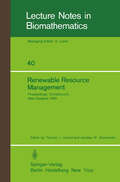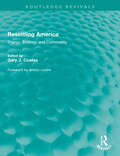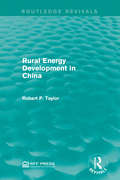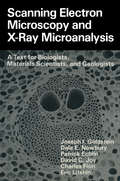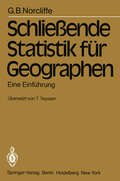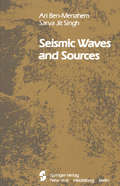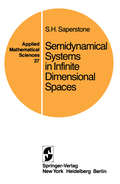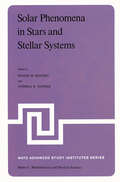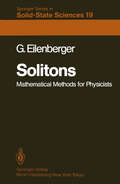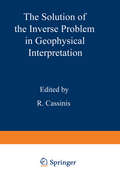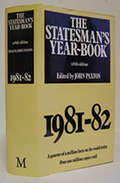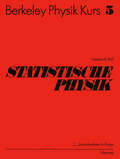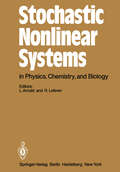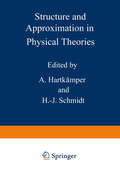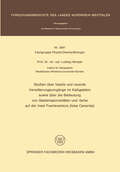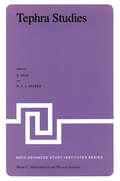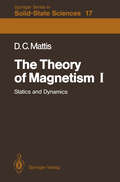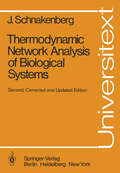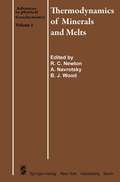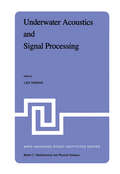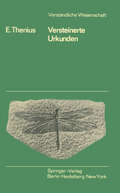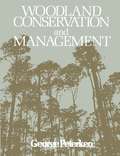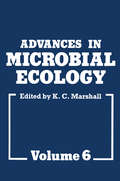- Table View
- List View
Renewable Resource Management: Proceedings of a Workshop on Control Theory Applied to Renewable Resource Management and Ecology Held in Christchurch, New Zealand January 7 – 11, 1980 (Lecture Notes in Biomathematics #40)
by Thomas L. Vincent Janislaw M. SkowronskiAs society becomes stressed by economic and population pressures, in turn, nature's renewable resources become stressed by harvesting pressures. For our own survival and euphoria, it is paramount that such resources remain as their name implies and not be driven to extinction through short term programs of over exploitation. Consideration of the harvesting of renewable resources leads to a simple question that was the theme of the workshop and is the focus of these proceedings: SUPPoRe you are assigned the role of manager for a specific renewable resource eco system. How would you decide on harvesting policies so that the system can be exploited economically yet at the same time maintain the integrity of the system? This, of course, is a loaded question. First of all, it is not clear that there is ever anyone single decision maker who is able to set the rules for all of the harvesters in an exploited ecosystem. The political process is complicated and to some extent unpredictable. This aspect of the question is recognized to be important, but could not be addressed here. Assuming then that someone really is in charge, what would be involved in the * decision making process? As Clark points out, "there is no alternative but first to model the system. " We agree. However, if the original question was loaded, modeling is the adulterate.
Resettling America: Energy, Ecology and Community (Routledge Revivals)
Every movement has its bellweathers, the ideas that lead the way and rally its adherents towards a set of shared values and visions. Resettling America was one such beacon – a publication for its time and ahead of its time. Those of us doing the work of sustainability and the transformation of communities feel grateful for Gary’s early and prescient contribution that has shaped the thinking of so many around the US and beyond. Essential reading for all green warriors! Jason F. McLennan, Chief Sustainability Officer – Perkins & Will. Founder, Living Building Challenge. Originally published in 1981 and now reissued with a new Preface by Gary J. Coates, Resettling America was one of the first comprehensive, transdisciplinary books on the crisis of sustainability and the implications of that crisis for the re-design of buildings, towns, cities and regions. Through essays by Coates, which provide a theory of ecological design, and case studies written by leading authors and activists of the time, the book presents a strategic vision of how it would be possible to create a sustainable and livable society through a process of cooperative community development rooted in a radical re-visioning of nature, self and society. By providing a strategic vision, as well offering practical means for creating a sustainable society worth sustaining, Resettling America remains more relevant and inspiring than ever to those who face the ecology of crises that now surround us in the 21st Century.
Resettling America: Energy, Ecology and Community (Routledge Revivals)
by Gary J. CoatesEvery movement has its bellweathers, the ideas that lead the way and rally its adherents towards a set of shared values and visions. Resettling America was one such beacon – a publication for its time and ahead of its time. Those of us doing the work of sustainability and the transformation of communities feel grateful for Gary’s early and prescient contribution that has shaped the thinking of so many around the US and beyond. Essential reading for all green warriors! Jason F. McLennan, Chief Sustainability Officer – Perkins & Will. Founder, Living Building Challenge. Originally published in 1981 and now reissued with a new Preface by Gary J. Coates, Resettling America was one of the first comprehensive, transdisciplinary books on the crisis of sustainability and the implications of that crisis for the re-design of buildings, towns, cities and regions. Through essays by Coates, which provide a theory of ecological design, and case studies written by leading authors and activists of the time, the book presents a strategic vision of how it would be possible to create a sustainable and livable society through a process of cooperative community development rooted in a radical re-visioning of nature, self and society. By providing a strategic vision, as well offering practical means for creating a sustainable society worth sustaining, Resettling America remains more relevant and inspiring than ever to those who face the ecology of crises that now surround us in the 21st Century.
Rural Energy Development in China (Routledge Revivals)
by Robert P. TaylorIn this title, originally published in 1981, author Robert P. Taylor calls for a greater understanding of rural energy supply and consumption patterns in the developing countries. Here, Taylor specifically examines the rural energy development in China as it is the world’s largest developing country in terms of population, and it has encountered many of the rural energy problems common in other developing countries. This study provides an analysis of China’s rural energy economy from before 1949 to a general discussion of achievements in rural energy development and the rural energy economy in 1981. This is an ideal title for students interested in environmental studies and development studies.
Rural Energy Development in China (Routledge Revivals)
by Robert P. TaylorIn this title, originally published in 1981, author Robert P. Taylor calls for a greater understanding of rural energy supply and consumption patterns in the developing countries. Here, Taylor specifically examines the rural energy development in China as it is the world’s largest developing country in terms of population, and it has encountered many of the rural energy problems common in other developing countries. This study provides an analysis of China’s rural energy economy from before 1949 to a general discussion of achievements in rural energy development and the rural energy economy in 1981. This is an ideal title for students interested in environmental studies and development studies.
Scanning Electron Microscopy and X-Ray Microanalysis: A Text for Biologists, Materials Scientists, and Geologists
by Joseph Goldstein Dale E. Newbury Patrick Echlin David C. Joy Charles Fiori Eric LifshinThis book has evolved by processes of selection and expansion from its predecessor, Practical Scanning Electron Microscopy (PSEM), published by Plenum Press in 1975. The interaction of the authors with students at the Short Course on Scanning Electron Microscopy and X-Ray Microanalysis held annually at Lehigh University has helped greatly in developing this textbook. The material has been chosen to provide a student with a general introduction to the techniques of scanning electron microscopy and x-ray microanalysis suitable for application in such fields as biology, geology, solid state physics, and materials science. Following the format of PSEM, this book gives the student a basic knowledge of (1) the user-controlled functions of the electron optics of the scanning electron microscope and electron microprobe, (2) the characteristics of electron-beam-sample inter actions, (3) image formation and interpretation, (4) x-ray spectrometry, and (5) quantitative x-ray microanalysis. Each of these topics has been updated and in most cases expanded over the material presented in PSEM in order to give the reader sufficient coverage to understand these topics and apply the information in the laboratory. Throughout the text, we have attempted to emphasize practical aspects of the techniques, describing those instru ment parameters which the microscopist can and must manipulate to obtain optimum information from the specimen. Certain areas in particular have been expanded in response to their increasing importance in the SEM field. Thus energy-dispersive x-ray spectrometry, which has undergone a tremendous surge in growth, is treated in substantial detail.
Seismic Waves and Sources
by A. Ben-Menahem S. J. SinghEarthquakes come and go as they please, leaving behind them trails of destruc tion and casualties. Although their occurrence is little affected by what we do or think, it is the task of earth scientists to keep studying them from all possible angles until ways and means are found to divert, forecast, and eventually control them. In ancient times people were awestruck by singular geophysical events, which were attributed to supernatural powers. It was recognized only in 1760 that earthquakes originated within the earth. A hundred years later, first systematic attempts were made to apply physical principles to study them. During the next century scientists accumulated knowledge about the effects of earthquakes, their geographic patterns, the waves emitted by them, and the internal constitution of the earth. During the past 20 years, seismology has made a tremendous progress, mainly because of the advent of modern computers and improvements in data acquisi tion systems, which are now capable of digital and analog recording of ground motion over a frequency range of five orders of magnitude. These technologic developments have enabled seismologists to make measurements with far greater precision and sophistication than was previously possible. Advanced computational analyses have been applied to high-quality data and elaborate theoretical models have been devised to interpret them. As a result, far reaching advances in our knowledge of the earth's structure and the nature of earthquake sources have occurred.
Semidynamical Systems in Infinite Dimensional Spaces (Applied Mathematical Sciences #37)
by Stephen H. SaperstoneWhere do solutions go, and how do they behave en route? These are two of the major questions addressed by the qualita tive theory of differential equations. The purpose of this book is to answer these questions for certain classes of equa tions by recourse to the framework of semidynamical systems (or topological dynamics as it is sometimes called). This approach makes it possible to treat a seemingly broad range of equations from nonautonomous ordinary differential equa tions and partial differential equations to stochastic differ ential equations. The methods are not limited to the examples presented here, though. The basic idea is this: Embed some representation of the solutions of the equation (and perhaps the equation itself) in an appropriate function space. This space serves as the phase space for the semidynamical system. The phase map must be chosen so as to generate solutions to the equation from an initial value. In most instances it is necessary to provide a "weak" topology on the phase space. Typically the space is infinite dimensional. These considerations motivate the requirement to study semidynamical systems in non locally compact spaces. Our objective here is to present only those results needed for the kinds of applications one is likely to encounter in differen tial equations. Additional properties and extensions of ab stract semidynamical systems are left as exercises. The power of the semidynamical framework makes it possible to character- Preface ize the asymptotic behavior of the solutions of such a wide class of equations.
Solar Phenomena in Stars and Stellar Systems: Proceedings of the NATO Advanced Study Institute held at Bonas, France, August 25–September 5, 1980 (Nato Science Series C: #68)
by R. M. Bonnet A. K. DupreeThis book represents the proceedings of a NATO Advanced Study Institute which was held at Bonas from August 25 till Sep tember 5, 1980 and was devoted to the study of "Solar Phenomena in Stars and Stellar Systems". It is intended for a broad audi ence. Students and post-doctoral scientists for example can dis cover new aspects of astrophysics. The general spirit of the ASI was aimed at presenting a unified aspect of astrophysical phenomena which can be studied intensively on the Sun although they are of a much more general nature. On the other hand, spe cialists in solar or stellar physics will find here the latest theoretical developments and/or the most recent observations made in their own field of research. An extensive bibliography will be found throughout the various sections, to which the reader may refer, for more detailed developments in various specific areas. In the past, stellar and solar astrophysics have more or less followed their own independent tracks. However, with the rapid development of modern techniques, in particular artificial satellites like the International Ultraviolet Explorer and the Einstein Observatory, which provide a new wealth of data, it appears that chromospheres, coronae, magnetic fields, mass loss and stellar winds, etc . . . . , are found not only in the Sun but occur also in other stars. Frequently these other stars represent quite different conditions of gravity, lumino~ity, and other parameters from those occurring in the Sun.
Solitons: Mathematical Methods for Physicists (Springer Series in Solid-State Sciences #19)
by G. EilenbergerThe Solution of the Inverse Problem in Geophysical Interpretation (Ettore Majorana International Science Series #11)
by R. CassinisAs is apparent from the table of contents, the lectures at the Third Course of the International School of Applied Geophysics, Erice, March 27-April 4, 1980 (the first part of this volume) dealt with several applications of inversion to different geophy sical methods. For every field, the more general lectures come first, followed by those aimed at more specialized objectives. Not all topics are covered and the coverage is not uniform. The seismological section (especially the seismic reflection methods) is the most developed, and this is only partly due to the actual state of the art. Unfortunately, only abstracts are available for two of the lectures. The second part of the volume contains some short notes and contributions presented either by the lecturers themselves or by other participants. They do not necessarily deal with the process of inversion itself but with the preparation and meaning of the data to be inverted or with some original treatments of problems that were discussed in the afternoon sessions. The discussion sessions and the round table that followed the lectures were essential to the success of the Course and to an understanding ot the difterent perspectives of the various specialists. I hope that the group of very brilliant and willing geophysi cists that made the meeting so interesting will stay ~n touch, grow closer, and meet again. Close scientific cooperation among them could contribute much to the "unification" of geophysical science.
The Statesman's Year-Book 1981-82 (The Statesman's Yearbook)
by John PaxtonThe classic reference work that provides annually updated information on the countries of the world.
Stochastic Nonlinear Systems in Physics, Chemistry, and Biology: Proceedings of the Workshop Bielefeld, Fed. Rep. of Germany, October 5–11, 1980 (Springer Series in Synergetics #8)
by L. Arnold R. LefeverThis book contains the invited papers of the interdisciplinary workshop on "Stochastic Nonlinear Systems in Physics, Chemistry and Biology" held at the Center for Interdisciplinary Research (ZIF), University of Bielefeld, West Germany, October 5-11, 1980. The workshop brought some 25 physicists, chemists, and biologists - who deal with stochastic phenomena - and about an equal number of mathematicians - who are experts in the theory of stochastic processes - together. The Scientific Commitee consisted of L. Arnold (Bremen), A. Dress (Bielefeld), W. Horsthemke (Brussels), T. Kurtz (Madison), R. Lefever (Brussels), G. Nicolis (Brussels), and V. Wihstutz (Bremen). The main topics of the workshop were the transition from deterministic to stoch astic behavior, external noise and noise induced transitions, internal fluctuations, phase transitions, and irreversible thermodynamics, and on the mathematical side, approximation of stochastic processes, qualitative theory of stochastic systems, and space-time processes. The workshop was sponsored by ZIF, Bielefeld, and by the Universities of Bremen and Brussels. We would like to thank the staff of ZIF and H. Crauel and M. Ehrhardt (Bremen) for the perfect organization and their assistance. In addition, our thanks go to Professor H. Haken for having these Proceedings included in the Se ries in Synergetics. Bremen and Brussels L. Arnold and R. Lefever December 1980 v Contents Part I. Introduction: From Deterministic to Stochastic Behavior On the Foundations of Kinetic Theory By B. Misr~ and I. Prigogine (With 1 Figure) ............................. .
Structure and Approximation in Physical Theories
by A. HartkamperThe present volume contains 14 contributions presented at a colloquium on "Structure and Approximation in Physical Theories" held at Osnabruck in June 1980. The articles are presented in the revised form written after the colloquium and hence also take account of the results of the discussion at the colloquium. It is a striking feature that the problem of approximation in physical theories has only recently found some attention in the philosophy of science, although the working physicist is con stantly confronted with those questions. No interesting theory of exact science exactly fits its experimental data; almost every relation between different theories is an approximate one. There fore an adequate reconstruction of physical theories must take into account and conceptualize the moment of approximation. The majority of the articles in this book is centered around this subject. There are at least two elaborate, 'structuralistic' approaches to the formalization of physical theories in which the aspect of approximation has been incorporated: the approach due to P. Suppes, J. Sneed, W. Stegmuller ("S-approach") and the approach of G. Lud wig and his co-workers ("L-approach"). The articles in this book correspondingly fall into three classes: presentation, elaboration and critique of the L-approach [Hartkamper/Schmidt, Ludwig, Neumann, Werner, Schmidt, Mayr, Kamiah, Majer, Grafe] or of the S-approach [Moulines, Balzer, Cooke], and articles referring to both approaches or concerned with related matters [Scheibe, Pfarr, Castrigiano]. Of course, this is only a rough classification and each article must be appraised in its own right.
Studien über fossile und rezente Verwitterungsvorgänge im Kalkgestein sowie über die Bedeutung von Gesteinsporositäten und -farbe auf der Insel Fuerteventura (Forschungsberichte des Landes Nordrhein-Westfalen #3047)
by Ludwig HempelTephra Studies: Proceedings of the NATO Advanced Study Institute ”Tephra Studies as a Tool in Quaternary Research”, held in Laugarvatn and Reykjavík, Iceland, June 18–29, 1980 (Nato Science Series C: #75)
by St. Self R. S. SparksProceedings of the NATO Advanced Study Institute `Tephra Studies as a Tool in Quaternary Research', Laugarvatn and Reykjavik, Iceland, June 18-29, 1980
The Theory of Magnetism I: Statics and Dynamics (Springer Series in Solid-State Sciences #17)
by Daniel C. MattisStarting with a historical introduction to the study of magnetism - one of the oldest sciences known to man - before considering the most modern theories and observations (magnetic bubbles and soap films, effects of magnetic impurities in metals and spin glasses), this book develops the concepts and the mathematical expertise necessary to understand contemporary research in this field. Magnetic systems are important in technology and applied science, but they are also prototypes of more complex mathematical structures of great importance to theoretical physics. These connections are made repeatedly in this volume. After development of the necessary quantum theory of angular momentum and of interacting electron systems, a number of models which have been successful in the interpretation of experimental results are introduced: the Ising model, the Heisenberg model, the Stoner theory, the Kondo phenomenon, and so on. In the second edition the thorough approach and the main features which made the first edition a popular text have been retained. All important theories are worked out in detail using methods and notation that are uniform throughout. Footnotes and an extensive bibliography provide a guide to the original literature. A number of problems test the reader's skill.
Thermodynamic Network Analysis of Biological Systems (Universitext)
by J. SchnakenbergThe first edition of this book was greeted with broad interest from readers en gaged in various disciplines of biophysics. I received many stimulating and en couraging responses, however, some of the book's reviewers wanted to stress the fact that an extensive literature of network theory was not included or reported in the book. But the main aspect of the book is intended to be substantive rather than methodical: networks simply serve as a remedy for doing some first steps in analysing and modelling complex biological systems. For an advanced stage in the investigation of a particular system it may be appropriate to replace the pheno menological network method by more detailed techniques like statistical equations or computer simulations. According to this intention, the second edition of the book has been enlarged by further biological examples for network analysis, not by more network theory. There is a completely new section on a network model for photoreception. For this section I am obliged to J. Tiedge who did most of the detailed calculation and to my colleague Professor Stieve with whom we have had a very fruitful cooperation. Also I would like to mention that this work has been sponsored by the "Deutsche Forschungsgemei nschaft" i n the "Sonderforschungsberei ch 160". Recent results for excitable systems represented by feedback networks have also been included in the second edition, especially for limit cycle networks.
Thermodynamics of Minerals and Melts (Advances in Physical Geochemistry #1)
by R. C. Newton, A. Navrotsky and B. J. WoodToday large numbers of geoscientists apply thermodynamic theory to solu tions of a variety of problems in earth and planetary sciences. For most problems in chemistry, the application of thermodynamics is direct and rewarding. Geoscientists, however, deal with complex inorganic and organic substances. The complexities in the nature of mineralogical substances arise due to their involved crystal structure and multicomponental character. As a result, thermochemical solutions of many geological-planetological problems should be attempted only with a clear understanding of the crystal-chemical and thermochemical character of each mineral. The subject of physical geochemistry deals with the elucidation and application of physico-chemical principles to geosciences. Thermodynamics of mineral phases and crystalline solutions form an integral part of it. Developments in mineralogic thermody namics in recent years have been very encouraging, but do not easily reach many geoscientists interested mainly in applications. This series is to provide geoscientists and planetary scientists with current information on the develop ments in thermodynamics of mineral systems, and also provide the active researcher in this rapidly developing field with a forum through which he can popularize the important conclusions of his work. In the first several volumes, we plan to publish original contributions (with an abundant supply of back ground material for the uninitiated reader) and thoughtful reviews from a number of researchers on mineralogic thermodynamics, on the application of thermochemistry to planetary phase equilibria (including meteorites), and on kinetics of geochemical reactions.
Underwater Acoustics and Signal Processing: Proceedings of the NATO Advanced Study Institute held at Kollekolle, Copenhagen, Denmark, August 18–29, 1980 (Nato Science Series C: #66)
by L. BjøøThe comprehensive research activity around the World in the fields of Underwater Acoustics and Signal Processing being strongly supported by new experimental technique and equipment and by the parallel fast developments in computer technology and solid state devices, which has led to a rapidly reducing cost of digital processing thus enabling more complex processing to be carried out economically, emphasize how necessary it is at intervals of a few years through a NATO Advanced Study Institute (NATO ASI) and guided by leading experts to study the conquests in the fields of Underwater Acoustics and Signal Processing. This need of study is moreover stressed by the interdisciplina rity of Underwater Acoustics and Signal Processing, where a strong impact from other branches of science, - Geophysics, Radioastronomy, Bioengineering, Telecommunication, Seismology, Space Research etc. - is taking place, which makes it an extre mely difficult task for scientists to follow-up the development in all its phases and to preserve the general view of its rapid ly increasing number of possibilities. The present Proceedings of the NATO ASI held in Copenhagen during August 1980 join the series of proceedings of NATO summer schools on Underwater Acoustics and Signal Processing held during the past 20 years. The equality and the fusion of the individual research fields of Underwater Acoustics and Signal Processing and the separate introduction of advanced research results from other scientific areas related to underwater acoustics such as transducers characterize the subject matter of this NATO ASI.
Versteinerte Urkunden: Die Paläontologie als Wissenschaft vom Leben in der Vorzeit (Verständliche Wissenschaft #81)
by E. TheniusWoodland Conservation and Management
by G. F. PeterkenProfessor John Harper, in his recent Population Biology of Plants (1977), made a comment and asked a question which effectively states the theme of this book. Noting that 'one of the consequences of the development of the theory of vegetational climax has been to guide the observer's mind forwards', i. e. that 'vegetation is interpreted asa stage on the way to something', he commented that 'it might be more healthy and scientifically more sound to look more often backwards and search for the explanation of the present in the past, to explain systems in relation to their history rather than their goal'. He went on to contrast the 'disaster theory' of plant succession, which holds that communities are a response to the effects of past disasters, with the 'climax theory', that they are stages in the approach to a climax state, and then asked 'do we account most completely for the characteristics of a population by a knowledge of its history or of its destiny?' Had this question been put to R. S. Adamson, E. J. Salisbury, A. G. Tansley or A. S. Watt, who are amongst the giants of the first forty years of woodland ecology in Britain, their answer would surely have been that understanding lies in a knowledge of destiny. Whilst not unaware of the historical facts of British woodlands, they were preoccupied with ideas of natural succession and climax, and tended to interpret their observations in these terms.
Advances in Microbial Ecology: Volume 6 (Advances in Microbial Ecology #6)
by K. C. MarshallThis volume of Advances in Microbial Ecology marks a change in the editor ship of the series. The Editorial Board wishes to take this opportunity to express its gratitude to Martin Alexander, the founding editor and editor of the first five volumes, for his enterprise in establishing the series and in ensuring that Advances has become an outstanding focal point for the identification of new developments in the rapidly expanding field of microbial ecology. With the publication of this volume, we welcome Howard Slater to the Editorial Board. The policies of the Editorial Board remain the same as before. Most con tributions to Advances in Microbial Ecology will be solicited by the Board. However, individuals are encouraged to submit outlines of unsolicited contri butions to the Board for consideration for inclusion in the series. Advances is designed to serve an international audience and to provide critical reviews on basic and applied aspects of microbial ecology. Contributions in the present volume are predominantly concerned with the ecology of aquatic microorganisms, but encompass a variety of approaches to this area. The exception is the chapter by J. W. Doran on the role of micro organisms in the cycling of selenium. G-Y. Rhee discusses the effects of envi ronmental factors on phytoplankton growth. The factors limiting the produc tivity of freshwater microbial ecosystems are considered by H. W. Paerl.
